Each January, right after the New Year, we turn our attention back to the orchard. It’s bare root fruit tree planting season!
Last summer we noted that two fruit trees in our orchard had sustained significant damage as a result of Meadow Voles. Last spring, for the first time, we had an explosion of Meadow Voles in the orchard and gardens, that caused significant damage to a number of plants.
As we don’t use poison baits on the farm, we elected to trap the voles, which is a lot of work, but with perseverance we were modestly successful at decreasing their populations.
However, voles are active night and day, 365 days a year, and their populations can quickly rise again. As an acre of land can support up to 500 voles, vigilance year around is critical to sustained control.
To prevent their populations from rising again this spring, addressing the voles now, in winter, is important to minimize our potential for damage later in the year.
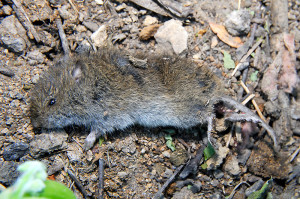
Meadow Voles can become plentiful where there is ample feed, and ground cover to protect them from predators
As we don’t use baits, we’re left with with habitat management, and trapping, as our best options for controlling our vole populations. Voles live in burrows underground, and use vast networks of surface runways to travel from burrow-to-burrow.
In the winter months, which is when most of the damage to plants occurs, voles can move around relatively undetected. They can construct their surface runways through snow, or protective vegetative cover. This enables them to avoid predation.
The most important thing we can do for vole control this time of year, is remove as much protective ground cover as possible near the fruit trees to force the voles out into the open where they’re exposed to predators, like owls, and hawks.
Removing the ground cover also removes the primary food source of the meadow voles, forcing them to go elsewhere to feed. [1,2]
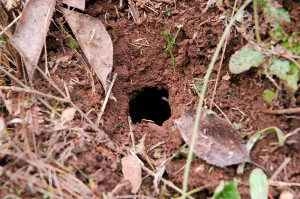
Vole holes are small and round. They don't make mounds of soil like gophers, nor do they push up surface soils like moles.
We’ve already noticed a few new tunnel entrances appearing on the orchard slope, so the past few days we’ve been removing all of the vegetation on the slope, except for the fruit trees. Sadly, this will mean few to no wildflowers in the orchard this spring. We’ll miss the flowers, as will our bees, but it’s a small price to pay compared to the extensive damage these tiny furry rodents did on the farm last year.
There is a suggestion that voles dislike crown vetch (Securigera varia)[1], which should thrive on our sunny orchard slope, and could be planted as a ground-cover to curb erosion, and to discourage the voles. However, this species is toxic to livestock, so for now at least, we’re opting to simply keep the ground clear.
With the vegetation cleared, for the remainder of the season we will need to be vigilant, keeping the grasses and weeds down as low as practically possible. Last year, with unrelenting rains, this was somewhat challenging, but so far this season the weather appears to be working in our favor.
With the slope all but scalped over the last few days, we then inspected the base of every single fruit tree in the orchard, as now is the perfect time for us to acquire replacements for any damaged trees. Vole damage, unlike deer, or rabbit damage, can frequently go undetected, so cursory visual inspections aren’t enough.[4]
All of our trees were fitted with both gopher wire around the roots, and with vole guards protecting the trunks at time they were originally planted. However, it was clear last year that the voles managed to defeat the trunk guards. Yesterday, we raised up each vole guard so we could inspect the trunk of every tree, and then the surface soil was pulled back all the way down into the root zone. This is because vole damage often lies below the soil line.

This is our Frost Peach. The damage caused by voles was entirely below the soil line, where the bark and cambium were stripped.
We knew the damage to our Frost Peach and our Bosc Pear trees last season was significant, so in November we had pre-ordered replacement trees. Our trees arrived just in time for the New Year, so yesterday we set out to remove the damaged trees.
It was so difficult to bring ourselves to dig out the peach tree. To our surprise there was already noticable bud swell on this tree, and the upper branches seemed remarkably healthy. The canopy did not even hint at the severity of damage below the soil line though.
Removing the soil around Frost, the magnitude of damage was readily apparent. At least 50-60% of the bark and cambium below the soil was gone. Not only that, but all of the major roots on the down-slope side of this tree were also severed.
Although this peach tree may survive this damage, and not die, the size of this defect around the trunk, and the missing roots, will significantly impede the flow of nutrients to the canopy. Last summer, the first clue something was wrong with this tree was that the leaves were continually wilting during warmer weather, when all of the other trees, including a neighboring Indian Free Peach, were just fine. This tree will always be set back, vigor will be always be reduced [3], and fruit set will never be optimal, so yesterday, reluctantly, we removed this Frost Peach from the orchard.
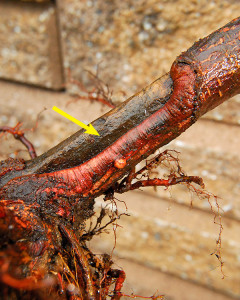
With the tree removed, and the damaged area rinsed, you can clearly see where bark is missing (yellow arrow)
We replanted with a new, healthy Frost Peach tree, on the same rootstock. Although the replacement tree was healthy, with a good trunk caliper, the graft union itself left a lot to be desired.
Too much root stock base protruded above the union, and left in place this could potentially trap soil or plant debris, and hold water against the trunk. Before this bare root peach was planted, we carefully removed the excess root stock, cutting at an angle to ensure it sheds water.
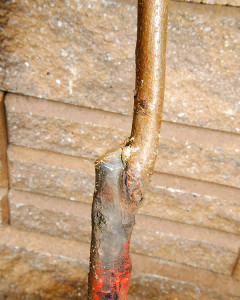
By trimming the excess rootstock, we'll prevent soil and debris from trapping moisture against the trunk
The cut was then wrapped in Parafilm to prevent the cut from desiccating while it heals.
In an attempt to prevent the voles from defeating the vole guards again, we modified the base of all of the guards on all the trees in the orchard, by flaring out the base slightly to ensure the bottom of the guards follows the angle of slope on the hill. We’re hoping this will make it somewhat more difficult for the voles to cheat underneath the guards.
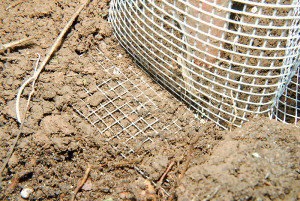
We've now toed out the base of each vole guard, and molded them to follow the angle of the slope on the hill in the hopes of preventing the voles from easily digging under
We’ll keep the vegetation cleared in the orchard, and cross our fingers that the owl box we built and installed over summer will find itself with a new vole-hungry resident moving in this spring.
As for the Bosc Pear, we’ve chosen to leave this tree in place for another season. Although approximately 25% of the tree was girdled at the base, the damage has healed somewhat, but to hedge our bets we’ve planted the replacement tree nearby.
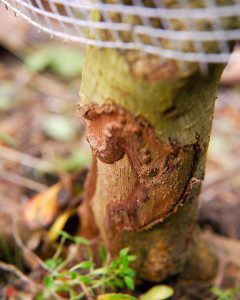
On closer inspection, the damage to Bosc was relatively less severe, so for now we've chosen to leave it in place
Best case scenario we’ll have two trees of the same variety in the orchard, but if the damaged Bosc fails to thrive and needs to be removed, its replacement is already in place.
In the meantime it will be up to us to keep a very watchful eye on the rate of vegetation growth in the orchard over winter and spring, especially once our rains return…at least we hope our rains return as right now we’re only just over 30% of our normal winter rainfall for this time of year.
We may never get rid of voles completely, but hopefully with good management we can keep their numbers within tolerable limits, and minimize potential for damage.
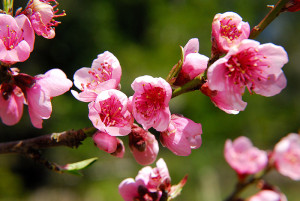
We're looking forward to our replacement Frost Peach producing these beautiful pink blooms in spring
It will take a couple of years for the new Frost Peach tree to set fruit, but we’re looking forward to making peach jam again in the very near future.
In the meantime, we’re excited that fruit tree grafting season is also upon us. The San Francisco and Monterey Bay Area Scion Exchanges, hosted by the California Rare Fruit Growers, are coming up in January:
January 15, 2012: Monterey Chapter Exchange, Cabrillo College, Aptos, Santa Cruz
January 21, 2012: Golden Gate Chapter Exchange, Laney College, Oakland
January 22, 2012: Sacramento Exchange, Cooperative Extension Offices, Sacramento
January 28, 2012: Redwood Empire Chapter Exchange, Veterans Hall, Sebastopol
For more information regarding these events, see here.
Scion exchanges are an excellent place to acquire material for grafting rare, unique heirloom fruit varieties, that aren’t readily availabe in area nurseries. Last season we grafted a number of apple and crab apple varieties. Who knows what we might find this year!?
——————-
[1] Identifying and Preventing Vole Damage. Colorado State University Extension.
[2] Protecting Trees from Vole Damage. Extension Notes. Ontario.
[3] Pearson, Karen. 1977. The Influence of Pine Vole Damage on Apple Tree
Vigor and Fruit Yield. Eastern Pine and Meadow Vole Symposia. University of Nebraska.
[4] UC IPM Online. How to Manage Pests. Pests in Gardens and Landscapes. Voles (Meadow Mice).

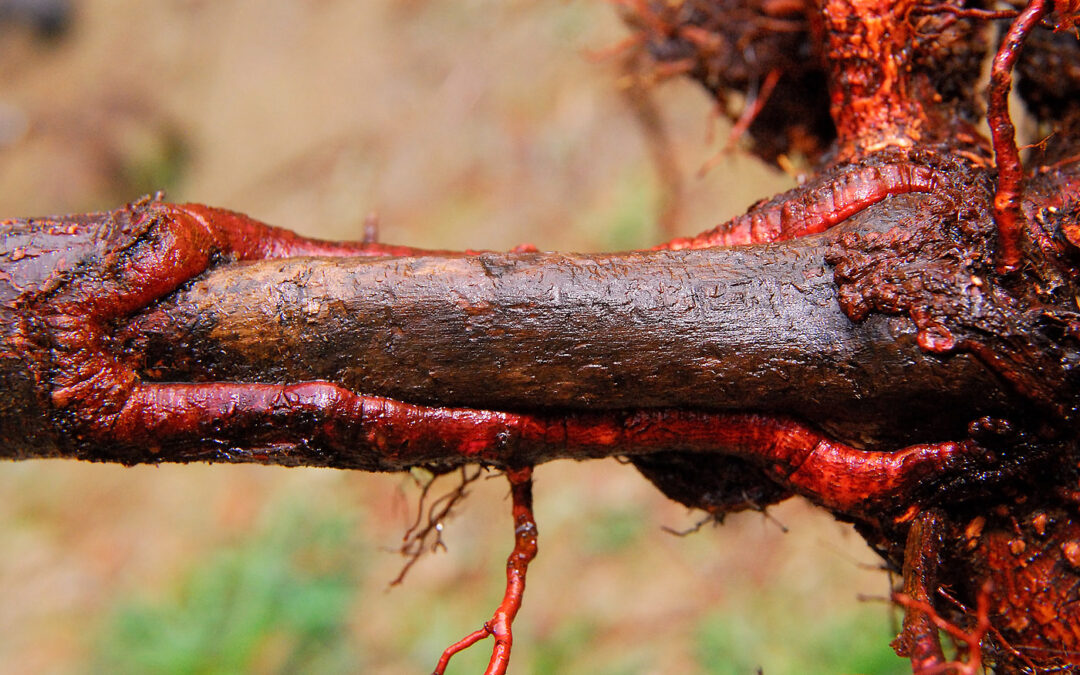
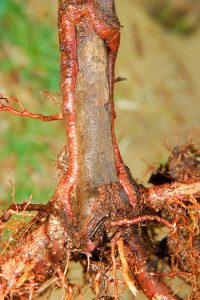
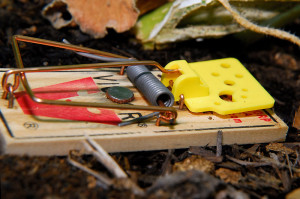

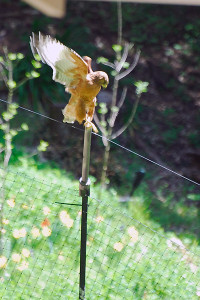
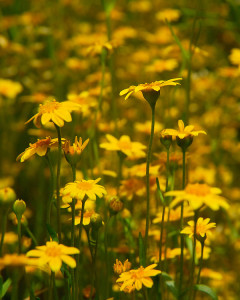
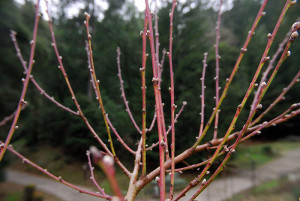
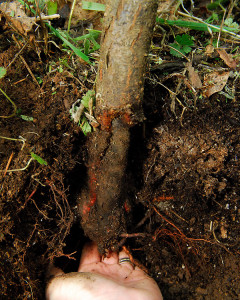
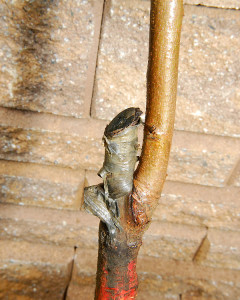
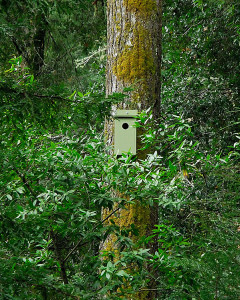







Hi Clare,
Sorry to see the problems with the voles, I do hope you manage to keep their numbers under control.
I think I’d be totally overwhelmed by the magnitude of the issue and feel completely helpless! I’d be tempted to put up a few Owl boxes in case none like the one you’ve put up – birds can be fussy may not like one but are happy with another 😀
I completely agree Liz! We have enough of the same scrap lumber left over in the workshop to hopefully build two or three more of these boxes over winter. I’ll be happy if an owl moves into just one of them! You’re right, they can be quite picky about their real estate! 😉
Clare we have similar destruction every winter into spring from voles under snow cover. I tried clearing the plant debris in fall but it is no good; they damaged other things…you have a much larger problem than I do and your ideas are clever and I might try a few of them…predators do not control them enough in my garden…they are the most persistent mind-boggling creatures and the critter I like the least..good luck!
I agree, voles are the most confounding creatures, and they make all our deer and gopher damage we experienced the first few years seem trivial in comparison! If we didn’t have animals here, with the intent of adding more in March, I’d be tempted to try the crown vetch. Anything to encourage these vile voles to move on!
Dear Clare – I’m so sorry to see the damage caused by the voles – they are the bane of my life too – although of course in my case its not as serious as with your wonderful fruit trees. Its a constant vigil for me to keep them controlled here and I could cry some days when I see the damage they cause. I wish you all the best in controlling them going forward!
They certainly can bring one to tears! I expect, once our trees are larger, the vole damage will eventually become less significant. For the last year though it has been inordinately frustrating!
Hi Clare! Happy New Year. Interesting that you are talking about the orchard today. I came over to tell you that I am current obsessed with an orchard for sale in rural South Carolina where I have imagined the garden of my dreams beside the little babbling brook there. I can take my little shasta camper out there on weekends and eat apples day and night. 🙂
I had forgotten completely about the whole problem of actually keeping the orchard..an orchard. Like voles and deers and stuff. hmmmm….
Well, I’m still obsessed with the idea. Its not practical (its 3.5 hours away), but I can’t quit visiting it online.
Deer and voles become much less of an issue though with established trees. Our trees are still very young, so even a little damage can do significant harm. Our neighbors have some more mature trees, and even though the deer occasionally nibble them, they can withstand the browsing much better. I think acquiring an established orchard sounds like a wonderful idea! 😉
Hard to fight something you can’t see until you see damage from it! Amazing that the root with so few roots was living at all! And to think that you won’t have your wildflowers because of this is so sad. Good luck.
I was very surprised that peach tree seemed to be doing so well when I saw the state of its roots yesterday. 😯 I honestly don’t know how it’s survived, except that this variety is very vigorous. There’s no question though, if we have drought this summer, this tree would have struggled. Hopefully staying on top of the vegetative growth in the orchard though will help, but I am quite sad to see the wildflowers go, especially as so many were starting to sprout for spring.
Clare,
From what I know about voles your on the right track. We have a female cat that has a problem with digestion it leaves her very hungry most of the time. She gets mice, moles and voles daily, along with birds and squirrels.
Wondering if you have any Comise pears in the orchard? I buy them at the co-op and they are the tastiest pears I have ever eaten, never seen them at any other grocery.
Sorry to hear about loosing the hive :(.
We don’t currently have any Comice pears Randy. Comice are very good, but require cold storage after harvest to mature, and honestly, we don’t have room! Bosc is best after cold storage too, so our fridges will be full just with that variety! 😉
Clare, like you we did a lot of preparation for vole damage this fall. I’ve even been meaning to do a post on it. Removing the grass and weeds seems one of the best management ideas I’ve seen. Since clearing our orchard of weeds and grass our only issues have been chipmunks and squirrels. The voles prefer the long meadow grass on the far side of the property.
I’m encouraged that your clearing seems to have helped. For us it seems to be the most practical thing we can do at this point. I hope it works!
I have been battling voles for years now and find that some years are worse than others.
I have used the mousetraps under “cover” with much success also. All those stupid sprays and granules are useless. I can’t believe I used to waste money on those. Thanks for the links, they are useful!
I read a paper last year that showed repellents are not effective against voles, so I didn’t try them. Vole populations do oscillate, and I wonder if last year was one of their peaks in their cycle. Regardless, I’m not taking any chances this year!
That is just painful to see Clare. I spend so much time at the tree farm and never took notice of this in the nursery fields, yet residential clients battle it constantly. I have to ask my friend how he deals with voles. I am pretty sure he does not poison them, so I wonder if nature just handles the problem. It will be an interesting answer, that or I just never paid close enough attention.
We didn’t seem to have any voles until last year, at least not that we noticed. The bulk of our problem last year was inside the deer fence perimeter. I can’t prove it, but I think that because this area is now fenced, that the ground predators can’t reach the voles as effectively as before (namely the bobcats, and coyotes on the farm). Our fence tipped a balance. That leaves us relying more heavily on our aerial predators, the hawks and owls, so I’m hoping that by exposing the voles through clearing ground covers, that we’ll help those predators to be more effective. We’ll keep trapping to supplement the effort though!
We are fighting the same battle. Albeit I don’t have such a large orchard to battle as you. I have lost so many plants and trees to these critters. Now everything we plant goes in with chicken wire screening, gravel and then soil to prevent them from getting to the roots. We haven’t tried traps yet because of our pets and children…someone else might get caught instead!
We’ve been considering mulching at the base of our fruit trees with a layer of gravel, to see if that might impede any voles from tunneling under our trunk guards.
You’re right, someone else might get caught in traps! We try to keep our traps covered with a piece of guttering, but I set so many traps last season that we ran out of tubing. I was in the squash patch in flip flops early one morning, and wasn’t paying attention…until I heard a loud SNAP under one of the squash leaves. I’d tripped a trap, and it just missed catching my toe by a fraction of an inch! 😯
Voles have done their share of damage to my own garden. We do have resident hawks and owls, and they are welcome! You have done a lot of work to prevent vole damage. I hope you are successful!
Our turkeys don’t like seeing the resident hawks circling overhead, but I’m always thrilled to see them, especially when they land in the orchard! 🙂
Claire, I have never seen so much damage . . . what horrid little voles! I hope your new set up works. The hawk and owls will be able to see better without the meadow flowers. They are lovely though. Wishing you the Happiest of New Years! Carol
Isn’t it something, they can do such an amazing amount of damage for being so small. Maybe the upside to all this will be a boost in our hawk or owl populations this spring. Goodness knows we have plenty of snack-sized voles to go around! 😛
I have had a time with the voles over the years as well. Some years are better than others which is probably due to their numbers. I stopped feeding birds with bird feeders because I realized they were using the food as a supplement and a good reason to find additional roots to eat in my garden. This probably kept them well fed while they multiplied. I am trying the feeders again this winter with bird feeders with trays that do not have a lot that falls to the ground. We’ll see how that works. I have also covered practically every plant root with granite chips. I want to try the owl house idea. I often talk to the owls, coaxing them with tales of good eats right here in the yard. Maybe the owl house will help. Good luck to you!
Vole populations are thought to ebb and flow from season to season, with occasional high-peak years. I hope we never see more voles than we saw last year, and I’m crossing my fingers for many fewer this season! We may try something like granite chips too, as they seem to favor soft soils. I’ll let you know if the owl house works out!
Voles have never been a problem until about two years ago and they still aren’t significant. However, my husband has been trapping mice in the furnace room on the first floor of our carriage house with an apartment on the second floor. He was astounded when he caught three voles. i am kind of worried. I never expected them to come inside so I think there must be a lot of them. We do have cats that regularly hunt.
Goodness, I would never have thought them to go inside either, although I remember Dave saying he caught one inside his greenhouse once. I really hope they stay out of our greenhouse! 😯
Dear Clare, So much mole damage is new to me… I am amazed. You are so knowledgeable, as I wouldn’t know where to begin. Wishing you a happy and more pest-free 2012! P. x
Oh Pam, I wish they were moles. I like moles, they eat the nasty grubs underground. The voles though, they’re like chainsaws with fur! Happy New Year! 🙂
Oh, I just can’t imagine how frustrating that must be. I’m having some issues with racoons mowing down my wildflowers right now, but they do seem to prefer Clarkias. I find it interesting how trying it can be when “nature” just does what she wants.
Some folks seem to think things will just balance out if left alone, but I think we’re far beyond that. Missing predators are a big component. I really admire how much you’re learning and sharing.
I had a raccoon problem in our first garden. We had lots of babies tears growing around the edges of the paths, and for some reason the thugs seemed to delight in ripping them up! I assumed maybe they were going after insects or slugs underneath, but it looked like the aftermath of a frat party by the time they were done! I hope they leave some of your Clarkias to bloom!
Hello Clare, 500 voles per square acre? That just made my eyes boggle! It seems even when the pests are small in stature in your part of the world, they make up for it in sheer numbers!
I’d believe it. The garden is only about 1/4 acre, and we must have easily had 50-100 of the beasts zipping around up there last summer. Prolific is an understatement for these rodents! I suppose they like the coastal climate as much as we do! 😉
Thank you so much! I have so many gophers and voles, and moles, and who know what else :(.
The gophers used to drive me crazy, but honestly I’d rather have them. I like the moles, as they don’t really damage plants per se, they just accidentally up root them while foraging for bugs. Voles though, I can’t stand!